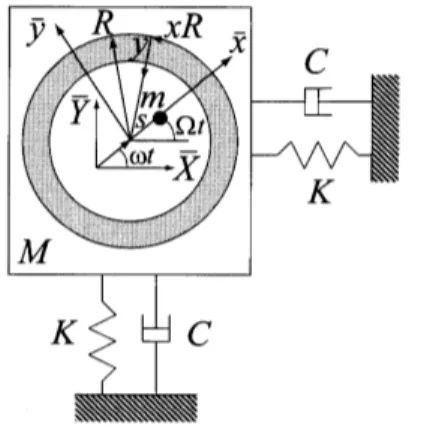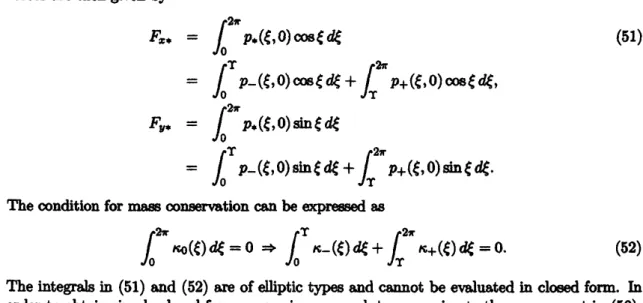Dynamics
of
the fluid balancer
MikaelA. Langthjem
\dagger,Tomomichi
Nakamura\ddagger\dagger Faeulty
of
Engineering, Yamagata University, Jonan4-chome, Yonezawa, 992-8510Japan\ddagger Department
of
Mechanical Engineering,Osaka
Sangyo University, S-l-l NoJcagaito, Daito-shi, Osaka,574-85S001
JapanAbstract
Thepaperis$\alpha\ovalbox{\tt\small REJECT}$utth the dynamios
of
aso-calledfluu
balatecer;ahulahoop–g-like smdun containing a small arnount
of
liquid which, durin rotation, is span out to $fmn$ athin liquid layer on the inersurface
of
the ring. The liquidis able to $mMemd$ $wMnoe$massin anelastically mounted rotor. The paper derives the equationsof
motionfor
$d\kappa$coupledfluid-structure
system, suith thefluid
equationsbasedonshallowwatertheory.An analytical aoledion to asinplified version
of
the shdlow waterequatio , describing ahydraulic jump, is discussedindetail.
1
Introduction
A fluidbalancerisused
on
rotatingmachinerytoeliminate theundaeirable$eff\infty ts$ofunbalancemass.
It hasbmmea
standard featureon
most household washing machines,but is alsousedon
heavyindustnial rotating machinery. Tbhngthe washing machine fluid balanoeras
example, it $\infty nsists$ofa
hollowning, likea
hulahoop ringbut typioellywith $r\infty\tan g_{J}1ar$cross
sections,which cont$\dot{u}$
ns
a
smallamountof liquid. When the ring is rotating ata
high angular velocity$\Omega$theliquidwillfom athinliquidlayer
on
the innersurfaceof theoutemostwall,as
sketchedinFig. 1. Consider the situation where
an
unbalanoemass
$m$ is present; for example the clothesinawashingmachine. The rotor hasacriticalangular velocity$\Omega_{cr}$ wherethecentripetalforoes
are
in balancewith the forces due to the restoringspmgs. Below this velocity $(\Omega<\Omega_{er})$ themass
centerofthe fluid will belocated ‘onthesame
side’as
the unbalance mass,as
shownin the left partof Fig. 1. [Here $M$indicatesthemass
of the emptyrotor and $\mathcal{M}$ themass
of the$\infty$ntaind liquid.] At acertain supercritical angular velocity $(\Omega>\Omega_{er})$ the
mass
centeroftheliquidwill
move
tothe’oppositeside’ of the unbalance mass,asshown in the right partof Fig.1, resultingin ‘massbalance’ andthusinareduoedoedlation amplitude of the rotor.
Figure 1: Workingprincipleofthefluid balancer.
This is the working principleof the fluidbalanoer, which has been verified$\ovalbox{\tt\small REJECT}$tally
[1]; but
no
$\infty ndtl\dot{a}ve$explanation has beengivenso
far. It is theaim of thepresent projecttoThepresentworkbuilds upon alargenumber ofstudies into the dynamicsand stabihtyof rotors partiaUyfilled withliquid [2, 3]. Non-linear studies havebeen camiedout by Beman $et$
al. [4], Coldmg-Jorgensen [5], Kasahara etal. [6], and Yoshizumi [7]. Beman et al. [4] found,
both by numerical analysis and by experiment, that non-linear surfaces
can
exist in the fomofhydraulic jumps, umdular bores, and solitary
waves.
[An undular bore is arelatively weakhydraulic jump, with undulations behind it.] Coldin$g$-Jorgensen [5] studiedsolely
a
hydraulicjump solution, inthespirit ofthe analysis of [4]. Onthe contraryto [4] and [5] the studiesof
Kasahara etal. [6] and Yoshizumi [7]
are
purelynumerical.To the best of
our
knowledge, theeffect ofan
unbalancemass
has not been studiedbefore.The system (with
an
unbalance mss) is however closely related to the so-called automaticdynamicbalancer [8] where
a
number ofballsrunning inacirculargrooveplaythesam
roleas
the liquid layer in the presentstudy.
As
[5] the present study is based largelyon
the approach ofBeman et al. [4]. However,$\infty ntrary$ to the one-degree-of-freedom assumptionin [4, 5], the presentwork$\infty$nideoe a rotor
withtwodegreesoffreedom.
2
Rotor equation
Consider arotatingvessel (rotatingfluidchamber) of
mass
$M$equippedwithasmallunbalancemass
$m$located adistance $s$fromthegeometric center,and$\infty nt-ng$a
small amountofliquid,as
sketchedin Fig. 2. The innerradius of the vessel is $R$.
Therotoris supported by springs,with spring constant $K$, in the $\overline{X}$
and $\overline{Y}$
directions. The structural dmpioe forces in these directions are proportional to the parameter $C$
.
Let the $\infty$oidinate system $(\overline{x},\overline{y})$ rotate withthe constantangular velocity$\Omega$ about the fixedsystem (X,Y).
Figure2: Definitionofcoordinatesystemsand
some
ofthe symbolsused. In temsofthe fixed$\infty$ordinatesystemtheequationof motion of the rotor isgivenby$\{\begin{array}{ll}M+m 00 M+m\end{array}\}\{\begin{array}{l}.\cdot X_{r}.\cdotY_{r}\end{array}\}+\{\begin{array}{ll}C 00 C\end{array}\}\{\begin{array}{l}\dot{X}_{r}\dot{Y}_{r}\end{array}\}$ (1)
$+$ $\{\begin{array}{ll}K_{x} 00 K_{y}\end{array}\}\{\begin{array}{l}X_{r}Y_{r}\end{array}\}=ms\Omega^{2}\{\begin{array}{l}\infty s\Omega ts\dot{m}\Omega t\end{array}\}+\{\begin{array}{l}F_{X}F_{Y}\end{array}\}$
.
Here$X_{r}$and$Y_{r}$
are
thedeflections of the rotor and$F_{Y},$ $F_{Y}$are
thefluid force$\infty mponents$actingthereon. An ‘overdot’ denotes differentiation withrespectto time$t$
.
The first temon
the righthand side shows that, in a fixed coordinate system, the unbalance
mss
introduces aperiodiclt will, however, be
more
$\infty nvenient$ to consider the $\infty upld$fluid-rotor motionin tmsoftherotating$\infty ordinate$system $(\overline{x},\overline{y})$
.
The deflaetionsinthetwocoordinate
systmsare
relatedbythe transfomations
$\{\begin{array}{l}x_{r}y_{r}\end{array}\}=\{\begin{array}{ll}m\Omega t s\dot{m}\Omega t-s\dot{m}\Omega t c\oe\Omega t\end{array}\}\{\begin{array}{l}X_{r}Y_{r}\end{array}\}$ , $\{\begin{array}{l}X_{r}Y_{\prime}\end{array}\}=\{\begin{array}{ll}\infty s\Omega t -s\dot{m}\Omega ts\dot{m}\Omega t c\infty\Omega t\end{array}\}\{\begin{array}{l}x_{r}y_{r}\end{array}\}$
.
(2)Applying (2) to (1)
we
obtaintheequation of motion intermsofrotating$\infty ordinat\alpha$as
$\{\begin{array}{ll}M+m 00 M+m\end{array}\}\{\begin{array}{l}.\cdot x_{r}\ddot{y}_{r}\end{array}\}+\{\begin{array}{ll}C -2(M+m)\Omega 2(M+m)\Omega C\end{array}\}\{\begin{array}{l}\dot{x}_{r}\dot{y}_{\prime}\end{array}\}$
$+$ $\{K_{x} -(M+m)\Omega^{2}C\Omega -C\Omega K_{y}-(M+m)\Omega^{2}\}\{\begin{array}{l}x_{r}y_{r}\end{array}\}$ (S)
$=$ $\{\begin{array}{l}ms\Omega^{2}0\end{array}\}+\{\begin{array}{l}F_{x}F_{y}\end{array}\}$
.
It is
seen
that, in this coordinate system, the unbalancemassintroducesa
foroe, proportionalto $\Omega^{2}$
, actingin thex-direction.
In order to evaluatethekdy foroe $\infty ting$
on
the fluid, the meleration vectorexpressed inthe rotating coordinate systm will beneeded;ltisgivenby
$\{\begin{array}{l}.\cdot X_{r}.\cdot\mathfrak{Y}_{r}\end{array}\}=\{\begin{array}{ll}1 00 l\end{array}\}\{\begin{array}{l}\mathfrak{X}_{r}\ddot{y}_{r}\end{array}\}+2\Omega\{\begin{array}{l}0-l10\end{array}\}\{\begin{array}{l}\dot{x}_{\prime}\dot{y}_{r}\end{array}\}-\Omega^{2}\{\begin{array}{ll}l 00 1\end{array}\}\{\begin{array}{l}x_{r}y_{r}\end{array}\}$
.
(4)3
Fluid equations
3.1 The
shaUow
water equations
The fluidmotion in the rotatin$g_{V\infty}1$will be described by
a
shalow water approximationofthe Navier-Stokesequations, and intermsof
a
$\infty$ordinatesystem $(x,y)$ attached to thewall oftherotor,
as
shown in Fig. 2. This coordinate system isrelated toa
polar$\infty ordInate$ system$(r,\theta)$ attached to the rotor (suchthat$\overline{x}=rcoe\theta,\overline{y}=r$sin$\theta$) inthe foUowing way
$x=R\theta$, $y=R-r$, (5)
where $R$is the radius of the vessel;
see
again Fig. 2. $x,y$are
rectmgular (Cartesian)coordi-nates,indicating that curvature effaetswill be ignored. This ispemissable whenthefluidlayer
thicknes$h(t,x)$is sufficiently smallin$\infty mpari\infty n$with the vessel radius$R$,i.e.,
1
$h(t,x)|/R\ll 1$forall $x,t$
.
Underthese $\infty umptions$the fluidequations of motion
can
be writtenas
[4, 9]$\frac{\partial u}{\partial t}+u\frac{\partial u}{\partial x}+v\frac{\partial u}{\partial y}-2\Omega v=-\frac{1}{\rho}\frac{\phi}{u}+\nu\frac{\partial^{2}u}{\partial y^{2}}+\ddot{X}_{r}aen(x/R)-\ddot{\mathfrak{Y}}_{r}coe(x/R)$, (6)
$\frac{\partial v}{\theta t}+2\Omega u+ffl^{2}=-\frac{1}{\rho}\frac{\Phi}{\partial y}$
.
(7)Here$u$and $v$
are
thefluidvelocity$\infty mponents$inthe $x$and$y$directions,$p$is thefluidpressure,$\rho$isthefluid density, and $\nu$thekinematicviscosity ofthe fluid. The$\infty ntinuity$equation is
The boundary$\infty nditims$
are
$u(O)=0$, $v(O)=0$, (9)
$( \frac{\partial h}{\partial t}+u\frac{\partial h}{\partial x})_{y=h}=v(h)$, $p(h)=0$,
where, again, $h(t,x)$specifies the free surface of the fluid layer.
Inthe shallow waterapprnimation it isassumed that
$v(t,x,y)= \frac{y\partial h}{h_{0}\theta t}$, (10)
where$h_{0}$ is the
mean
fluiddepth. Then (7)can
be writtenas
$\frac{y}{h0}\frac{\partial^{2}h}{\partial t^{2}}+2\Omega u+R\Omega^{2}=-\frac{1}{\rho}\frac{\partial p}{\mathfrak{B}}$
.
(11)Thisequation
can
be integrated, togive$\frac{1}{\rho}p(y)=\frac{1}{2h_{0}}(h_{0}^{2}-y^{2})\frac{\partial^{2}h}{\partial t^{2}}+2\Omega l^{h}udy+R\Omega^{2}(h-y)$
.
(12)Inserting(12) into (6) weget
$\frac{\partial u}{\theta t}+u\frac{\partial u}{\partial x}+v\frac{\partial u}{\partial y}=-R\Omega^{2}\frac{\partial h}{\partial x}+2\Omega\frac{\partial h}{\partial t}-\frac{1}{2h_{0}}(h_{0}^{2}-y^{2})\frac{\partial^{3}h}{\partial x\partial t^{2}}+\nu\frac{\partial^{2}u}{\partial y^{2}}+S$ , (13)
where,here andin thefollowing,
$\mathfrak{F}=\ddot{X}_{v}\sin(x/R)-\ddot{\mathfrak{Y}}_{r}\infty s(x/R)$
.
(14)Let
$U= \frac{1}{h}\int_{0}^{h}udy$ (15)
denote the
mean
flowvelocityin thex-direction. Applying this ‘operator‘to (13)weget$\frac{\partial U}{\theta t}+U\frac{\partial U}{\partial x}+\frac{h_{0}}{3}\frac{\theta^{8}h}{\partial x\theta t^{2}}+R\Omega^{2}\frac{\partial h}{\partial x}-2\Omega\frac{\partial h}{\theta t}-\eta U^{2}-\nu_{ev}\frac{\partial^{2}U}{\partial x^{2}}=S$, (16)
where
$\eta U^{2}$ $=$ $- \frac{\nu}{h_{0}}[\frac{\partial u}{\partial y}]_{y=0}$ (17)
$\nu_{ev^{\frac{\partial^{2}U}{\partial x^{2}}}}$
$\doteqdot$ $- \frac{\partial}{\partial x}\frac{1}{h_{0}}\int_{0}^{h_{O}}(u-U)^{2}dy$
are
modekfor dissipationdue to wall friction andinternalfluidfriction, respectively [4, 9]. In the first equation$\eta$is a hiction coeMcient (knownfrom head loss inpipe flow) and $v_{ev}$ in thesecondequationis
a
so.callededdy viscositycoefficient. In (16) and (17) it hasbeen used that$\frac{1}{h}\int_{0}^{h}u\frac{\partial u}{\partial x}dy+\frac{1}{h}\int_{0}^{h}v\frac{\partial u}{\partial y}dy\approx$ (18)
$\frac{\partial 1}{\partial xh_{0}}\int_{0}^{h_{0}}(u-U)^{2}dy+\frac{\frac{1}{h_{0}}U\int_{0}^{ho}\frac{\theta u}{\partial x}dy}{U\mathscr{X}}$
Applying(15)to the$\infty nMuity$equation (8), thelatter
can
be writtenas
$\frac{\partial h}{\theta t}=-\frac{\partial(hU)}{\partial x}$
.
(19)At thispoint
we
introduoe thetraveM
wave’ variable$\xi=x/R+(\Omega-\omega)t$ (20)
Here$\omega$istheangularwhirling velocity ofthevessel, which isassumedto beclose,but notequal,
to theimposedangularvelocity$\Omega$
.
Writing$U=U(\xi)$, $h=h_{0}+h’(\xi)$, (21)
(16)
can
be writtenas
(25)
$- \Omega(\Omega-2v)\frac{\partial h^{l}}{\partial\xi}+(\Omega-\omega)\frac{\partial U}{\partial\xi}=$ (22)
$- \frac{U}{R}\frac{\partial U}{\partial\xi}+\frac{\iota\tau\partial^{2}U}{R^{2}\partial\xi^{2}}+\eta U^{2}-\frac{h_{0}(\Omega-\omega)^{2}\partial^{3}h’}{3R\partial\xi^{\theta}}+\ddot{x}_{r}$
sm
$(x/R)-\ddot{\mathfrak{Y}}_{r}\infty s(x/R)$The$\infty ntinuity$equation (19)
can
bewrittenas
$( \Omega-\omega)\frac{\partial h’}{\partial\xi}+\frac{h_{0}\partial U}{R\partial\xi}=-\frac{U}{R}\frac{\partial h’}{\partial\xi}-\frac{1}{R}h’\frac{\partial U}{\partial\xi}$
.
(23)It is noted that the left sides of(22) and (23) ge linearin the unknown variables $U$ and $h’$,
while the right sides
are
non-linear. In the followingwe
consider the lineanzed equations. In order forthm to havea
non-trivialsolution, the deteminant must beequalto zero,$|\begin{array}{lll}-\Omega(\Omega -2\omega) \Omega-\omega\Omega-\omega h_{0}/R\end{array}|=0$
.
(24)Thepossiblewhirlng frequencies
are
thus$\omega=\Omega[1+\frac{h_{0}}{R}\pm\{\frac{h_{0}}{R}(1+\frac{h_{0}}{R})\}^{\frac{1}{2}}]$
.
(26)
As thespeed of thecylinder is ffll, thepossible speedsof
a
travelingsurfaoewave
are
$c_{\pm}=lm[ \frac{h0}{R}\pm\{\frac{h_{0}}{R}(1+\frac{h0}{R})\}^{A}2]$
.
3.2
Non-dimensionalization
lowmg parameters$\mathfrak{N}e$introduced:
$\epsilon=\frac{\frac{1}{2}\rho R^{2}L}{M}$,
$\delta=\frac{h_{0}}{R}$, $\kappa=\frac{h’}{R}$, $\omega_{*}=\frac{\omega}{\omega}$, $\omega_{*}=\sqrt{\frac{K}{M}}$, $\Omega_{*}=\frac{\Omega}{\omega_{l}}$, (27)
$t_{*}=\epsilon\Omega\sqrt{\frac{h_{0}}{R}}t$, $\emptyset=m\sqrt{\frac{h_{0}}{R}}$,
$x_{*}= \frac{x_{r}}{h_{0}}$, $y_{*}= \frac{y_{r}}{h_{0}}$,
The pmmeter $q\infty rraeponds$ to the shallow water
wave
speed $(gh_{0})^{\frac{1}{2}}$, but here the gravity acceleration9 is the centrifugal acceleration$R\Omega^{2}$.
The parmeter $\epsilon$ expresses, except for
a
factor $2\pi$, the ratio between fluidmass
and themass
of the (empty) rotor. It is assumed tobe smalland lsused in (27) andthe followingas
a bookkeepin$g$parameter’,in order tocomparethe magnitude of the individual tems.A non-dimensionalversion of(22) can nowbe obtainedas follows
$-(1-2 \overline{\omega})\frac{\partial\kappa}{\partial\xi}+\delta^{-\perp}2(1-\tilde{\omega})\frac{\partial U_{*}}{\partial\xi}=$ (28)
$- \epsilon U_{*}\frac{\partial U_{*}}{\partial\xi}+\epsilon v_{*}\frac{\theta^{2}U_{*}}{\partial\xi^{2}}+\epsilon\eta_{*}U_{*}^{2}-\epsilon\frac{1}{3}\delta(1-\tilde{\omega})^{2}(\frac{1}{\epsilon}\frac{\partial^{s_{l\}}}{\partial\xi^{8}})$
$+ \epsilon[\epsilon^{2}\delta x_{*}’’-2\epsilon\delta^{\frac{1}{2}}Of-x_{*}]\sin\frac{x}{R}-\epsilon[\epsilon^{2}\delta y_{*}’’+2\epsilon\delta^{1}\pi_{X_{*}’-y_{*}]coe\frac{x}{R}}$
where$\tilde{\omega}=\omega/\Omega=\omega_{*}/\Omega_{*}$
.
A dashreferstodifferentiation withrespect to$t_{*}$.
The$\infty ntinuity$equation (23)
can
bewrittenas
$(1- \overline{\omega})\delta^{-1}2\frac{\partial\kappa}{\partial\xi}+\frac{\partial U_{*}}{\partial\xi}=-\epsilon\{U_{*}\frac{\partial\kappa}{\partial\xi}+\kappa\frac{\partial U_{*}}{\partial\xi}\}$ (29)
3.3
Perturbation analyisThe variables which
are
functionsof thetraveM
waveparmeter’ $\xi$are
expanded asfollows:$\kappa=\kappa_{0}+\epsilon\kappa_{1}+\cdots$ , $U_{*}=U_{0}+\epsilon U_{1}+\cdots$ , $\tilde{\omega}=\overline{\omega}_{0}+\alpha\tilde{0}_{1}+\cdots$
.
(30)Collecting thecoefllcientsof$\epsilon^{0}$
we
obtainthe nonAimensional versions of the left handsidesof(22) and (23),
$-(1-2 \tilde{v}_{0})\frac{\partial\kappa 0}{\partial\xi}+\delta^{-r}(1-\tilde{\omega}_{0})\frac{\partial U_{0}}{\partial\xi}1=0$, (31)
$\delta^{-\frac{1}{2}}(1-\tilde{\omega}_{0})\frac{\partial\kappa 0}{\partial\xi}+\frac{\partial U_{0}}{\partial\xi}=0$
.
(32)Thedeteminant equation,
$|\delta^{-}\}(1-\tilde{\omega}_{0})-(1-2\tilde{\omega}_{0})$ $\delta^{-1}z(1-\tilde{\omega}_{0})1|=0$, $(3S)$
thengivesthe
non-dimensional
version of(25),$\overline{\omega}_{0}=1+\delta\pm(\delta+\delta^{2})^{\frac{1}{2}}$
.
(34)The non-dimensionalversion ofthewavenumberequation (26) is
$c\pm=c_{0}\{\delta^{\frac{1}{2}}\pm(1+\delta)^{\frac{1}{2}}\}$, (35)
In (35) the $+$ solution corresponds to $progr\infty ive$
waves
and the – solution to a retrogradewave.
Experimentsshowthat onlythe lattertypeexists; accordinglythe–solution is used inthe following. The$\infty ntinuiW$equation(32) nowgives
Employing this$\infty\infty ion$
,
the temsproportionalto $\epsilon^{1}$inthe
msion
of(28)can
bewrittenas
$A_{1} \frac{\partial\kappa 0}{\partial\xi}-B_{1}\kappa_{0}\frac{\partial\kappa_{0}}{\partial\xi}-C_{1}\frac{\partial^{3_{\hslash}}0}{\partial\xi^{3}}+D_{1}\frac{\partial^{2}\kappa 0}{\partial\xi^{2}}+E_{1}\kappa_{0}^{2}=x_{*}f\dot{fl}n\xi-y_{*}\infty s\xi$ , (37)
where
$A_{1}=-2 \tilde{v}_{1}\frac{\sqrt{\delta+\delta^{2}}}{\delta}$, $B_{1}=3( \frac{c_{-}}{c_{0}})^{2}$, $C_{1}= \frac{1}{3\epsilon}\delta^{2}(\frac{c_{-}}{c_{0}})^{2}$, (38)
$D_{1}= \nu_{n}\frac{c_{-}}{c0}$, $E_{1}= \eta_{*}(\frac{c_{-}}{c0})^{2}$
In (37) ithasbeenassumed that sin$\xi\approx\sin x/R$and$coe\xi\approx mx/R$
.
The non.dimensionaJ versionofthe pressure equation (12), evaluated
on
the vessel surfaoe$y=0$, takes the fom
$p_{*}(0)=\epsilon\{\delta^{2}(\frac{c_{-}}{c0})^{2}\frac{\partial^{2}\kappa_{0}}{\partial\xi^{2}}+2(1+2\delta^{\frac{1}{2}}\frac{c_{-}}{\alpha})\kappa 0\}+O(\epsilon^{2})$
.
(39)4
Fluid-structure
coupling
4.1 Non-dimensionalization of the rotor equation
In order toputthe rotorequation (3)into$non\ovalbox{\tt\small REJECT} onal$ fomanumberofadditionalvariables
are
introduced:$\mu=\frac{m}{M}$, $\zeta=\frac{C}{\sqrt{MK}}$, $F_{x},$ $= \frac{F_{x}}{h_{0}K}$, $F_{y}$
.
$= \frac{F_{y}}{h_{0}K}$, $\sigma=\frac{s}{R}$, (40)$\omega_{0}^{2}=\frac{K_{x}}{M}$, $\chi=\frac{K_{y}}{K_{x}}$
.
Applyingtheseto(3)undertheassumptionthat the rotor undergoes steadywhirlwith ffequency
$\tilde{\omega}_{0}$,
we
obtain$\epsilon^{2}[-\tilde{\omega}_{0}^{2}\{\begin{array}{lll}1+\mu 0 0 l+ \mu\end{array}\}+i\tilde{\omega}_{0}\{\begin{array}{lll}\zeta\overline{\omega}o -2(l+\mu)2(1+ \mu) \zeta\overline{\omega}o\end{array}\}$ (41)
$+$ $[\overline{\omega}_{0}^{2}-(1+\mu)\Omega_{l}^{2}\zeta\Omega_{*}$ $\chi\overline{\omega}^{2}0^{-\zeta\Omega_{s}}-(1+\mu)]]\{\begin{array}{l}x_{*}y\end{array}\}$
$=$ $\epsilon^{2}\{\begin{array}{l}\mu\sigma\delta^{-\xi}0\end{array}\}+\epsilon\{\begin{array}{l}F_{g*}F_{y*}\end{array}\}$ ,
where$\overline{\omega}_{0}=\omega_{0}/\Omega$
.
4.2 Fluid forcesThefluidforcecomponents$F_{x}$and$F_{y}$
on
therighthand side of(3)can
besplitup intopressure-and friction-relatedparts, indicatedby sukcripts$p$and$f$respectively,
as
follows:$\frac{F_{xp}}{RL}$ $=$ $\int_{0}^{2\pi}p(O)coe\xi d\xi$, $\frac{F_{w}}{RL}=\int_{0}^{2\pi}p(0)$Sn$\xi\not\in$, (42)
where$L$isthe lrgth(heigt)ofthevessel. Inthefollowing only thepressure-relatedtermswill
be considered. The non-dimensionalversion oftheseterms- to beinserted into (41)-take the
simplefoms
$F_{x}$
.
$= \int_{0}^{2\pi}p_{*}(\xi,0)\cos\xi*$, $F_{y*}= \int_{0}^{2\pi}p_{*}(\xi,0)\sin\xi\not\in$.
(44)5
Hydraulic
jump solution
Thefirst threetems
on
thelefthand sideof (37) representaKorteweg-de Vries-typeequation,while the first, second, and fourth tem represent a Burgers-type equation. The homogeneous Korteweg-de Vriesequation isknown to have analyticalsolutionsinforms of solitaryand cnoidal
waves, depending
on
the boundary conditions. Analytical solutions to homogeneous andnon-homogeneous Burgersequations
are
also known [9, 10]. Onthe otherhand, analytical solutions to non-homogeneous Korteweg-de Vries equationsare
known onlyfora
few special cases, e.g.[11]. In whatever way, the forced Korteweg-de Vries-Burgers equation (37) is expectedto have
avarietyof interestingsolutions.
We seek a solution which can
extinR’
the forcingeffect of the unbdancemass
and it is instructiveto obtain asimple, analytical solution,even
ifone hasto ‘oversimplify’the basicequations,thatis,tomakeassumptionsthat
are
not fully physicalsound. The solution obtainedinthiswayshouldthenbeassessed bycomparisonwith analytical
or
numerical solutionsof the(physicaJlysound) basic equations.
Such asolution of(37)
can
beobtained ifoneassumes:
$\bullet$ nodispersion $\Rightarrow\theta^{8}\kappa_{0}/\partial\xi^{3}=0$;
$\bullet$ no$hiction\Rightarrow\nu_{*}=\eta_{*}=0$
.
Then it reducesto
$A_{1} \frac{\partial\kappa 0}{\partial\xi}-B_{1}\kappa_{0}\frac{\partial\kappa_{0}}{\partial\xi}=x_{*}$sin$\xi-y_{*}coe\xi$, (45)
Integration gives
$A_{1} \kappa_{0}-\frac{1}{2}B_{1}\kappa_{0}^{2}=-x_{*}coe\xi-y_{*}$
sm
$\xi+A$, (46)where$\mathcal{A}$is
an
integration constant. Solving (46) withrespectto$\kappa_{0}$ gives
$\kappa_{0}(\xi)=\frac{A_{1}}{B_{1}}\pm\{(\frac{A_{1}}{B_{1}})^{2}+\frac{2}{B_{1}}(x_{*}\cos\xi+y_{*}$sin$\xi-A)\}^{\#}$ (47)
The change of sign $(\pm)$ in (47) gives a dis ntinuity which represents
a
hydraulic jump,as
illustrated in Fig. 3. Let the jump belocated at $\xi=\prime r,$ $0<\prime r<2\pi$, in terms of the rotating
polar$\infty$ordinatesystemdiscussedinthebeginningofSection 3. Assunuing thatit isnotlocated
at$\xi=0$
or
$2\pi$ (i.e. atthesme
locationas
the unbalancemass) givesthe following ‘smoothnaescondition’ at thispoint;
$\kappa_{0}(0)=\kappa_{0}(2\pi)$
.
(48)The$\infty nstant\mathcal{A}$
can
bedetemined fromthis condition, whichgives$\mathcal{A}=\frac{B_{1}}{2}(\frac{A_{1}}{B_{1}})^{2}+x_{*}$
.
(49)Thesolutionof(45) isthengiven by
Figure3: Sketch of the hydraulicjump solution, eqn. (50).
Let$p\pm(\xi,0)$ be the fluidpressure $\infty rraepondi_{\mathfrak{X}}$tothedepthperturbation $\kappa\pm(\xi)$
.
Thefluidforces
are
thengivenby$F_{x*}$ $=$ $\int_{0}^{2n}p.(\xi,0)\infty s\xi\not\in$ (51) $=$ $\int_{0}^{T}p_{-}(\xi,0)m\xi\not\in+\int_{1}^{l\pi}p+(\xi,0)$
oos
$\xi\not\in$,$F_{y*}$ $=$ $\int_{0}^{2\pi}p_{*}(\xi,0)$stn$\xi d\xi$
$=$ $\int_{0}^{\iota}p_{-}(\xi,0)s\ln\xi d\xi+\int_{r}^{2\pi}p+(\xi,0)\dot{a}n\xi\not\in$
.
The$\infty ndition$for
mass
$\infty nmvation$can
beexpressedas
$\int_{0}^{2\pi}\kappa\circ(\xi)d\xi=0\Rightarrow\int_{0}^{T}\kappa_{-}(\xi)d\xi+\int_{r}^{2\pi}\kappa+(\xi)*=0$
.
(52)The$inte\Psi^{a1_{8}}$in (51) and (52)
are
of elliptic typesandcannot beevaluatedin closedfom. Inorder toobtainsimpleclosed-fomexpressions
we
seektoapproximate the squarerootin (50).As both tems under the square root
are
of thesme
order of$ni_{\dot{K}}tude$a
kylorexpansiondoesnot exist.
But by assuming that $x_{r},y_{*}\ll 1$, Lanczoe’s tau method [12]
can
be used. Logarithmicdifferentiation of the function $f(x)=\sqrt{x}$gives the differential equation $f’(x)-\#_{l}^{1}f(x)=0$
.
The initial $\infty nditionf(O)=0$
assures
the solution $f(x)=\sqrt{x}$.
The tau method howeverapproximates thesolutionvla expansion $\ln$ Chebyshev$polyno\dot{m}\triangleleft s$
.
Retaining onlythe linearpartofthis$\infty ansion$,
we
obtain$\sqrt{x}\approx\frac{1}{3}(1+2x)$
.
(53)Equation (50)can thus be apprcximatedas
$\kappa_{0}(\xi)=\kappa\pm(\xi)=\frac{A_{1}}{B_{1}}\pm\frac{1}{3}(\frac{2}{B_{1}})^{\#}\{1+2x_{t}(m\xi-1)+2y_{8}\dot{m}\xi\}$
.
(54)Using thisexpression the integralsin (51)and (52)
can
be evaluatedinclosed fom. Doing thiswe
obtain the$\infty upled$fluid-structureequationsystm$[-\overline{\omega}_{0}^{2}\{\begin{array}{ll}1+\mu 00 l+\mu\end{array}\}+i\tilde{\omega}_{0}\{\begin{array}{ll}\zeta\overline{\omega}_{0} -2(1+\mu)2(1+\mu) \zeta t\overline{h}\end{array}\}$ (55)
$+$ $\{\begin{array}{ll}\overline{\omega}_{0}^{2}-(l+\mu)\Omega_{*}^{2} -\zeta\Omega_{*}\zeta\Omega_{l} \chi\overline{\omega}_{0}^{2}-(1+\mu)\end{array}\}+\{\begin{array}{ll}\mathfrak{F}_{lx} s_{xy}S_{\Psi} s_{\nu\nu}\end{array}\}]\{\begin{array}{l}x_{*}y_{*}\end{array}\}$
where$\_{xx},$$\ldots,F_{rx},$$\ldots$
are
functionsofthejumplocation $\ell r$,given by$s_{xx}$ $=$ $-2\mathcal{K}_{1}\{\mathcal{P}_{0(r\prime}-coe’r\dot{m}1^{\cdot}+2\dot{m}^{\prime r\prime}-r+\pi)+\mathcal{P}_{1}(\infty 8^{\prime r_{\sin’}}+r-\pi)\}$ , (56)
$\mathfrak{F}_{xy}$ $=$ $-2\mathcal{K}_{1}(P_{0}-\mathcal{P}_{1})(\cos^{2} T- l)$,
$\mathfrak{F}_{\Psi}$ $=$ $-2\mathcal{K}_{1}\{\mathcal{P}_{0}(coe^{2} T- 2coe’r+1)+\mathcal{P}_{1}(1-2\cos^{2}1’)\}$,
$S_{yy}$ $=$ $-2\mathcal{K}_{1}(\mathcal{P}_{0}-\mathcal{P}_{1})(coe$Tsin$\prime r+’r-\pi)$, $\mathcal{F}_{rx}$ $=$ $-2\mathcal{K}_{1}\mathcal{P}_{0}$sin 1,
$F_{ry}$ $=$ $-2\mathcal{K}_{1}\mathcal{P}_{0}(1-\infty s^{\prime r)}$
.
Herein
$\mathcal{P}_{0}$ $=$ $2(1+2 \delta^{\iota}2\frac{c_{-}}{c_{0}})$ , $\mathcal{P}_{1}=\delta^{2}(\frac{c_{-}}{c_{0}})^{2}$, (57)
$\mathcal{K}_{0}$ $=$ $\frac{A_{1}}{B_{1}}$, $\mathcal{K}_{1}=\pm\frac{1}{3}(\frac{2}{B_{1}})^{\#}$
The
mass
conservationequation (52) takesthe fom$2\mathcal{K}_{1}\{(-\dot{m}r-\pi)x_{*}+(coe1^{4}-1)y_{*}\}+\mathcal{K}_{0}\pi+\mathcal{K}_{1}(\pi-r)=0$
.
(58)Foragivenangular velocity$\Omega_{*},$ (55)and (58)$cont\dot{m}$threeequationsfor the
three unknowns
$x_{*},$$y_{*}$, and $r$, which
can
be solvedtogether numerically. [Here, $\mathcal{K}_{0}$issetequal tozero
in (58).]In thenumericalexampletofollowwe set $\delta=0.125,$$\mu=0.25,$ $\zeta=13.0,$$\sigma=0.4$, and$\chi=1.0$
.
InFig. 4,part (a) shows therotoramplitudes$x_{*}$ and$y_{*}$,whilepart (b)shows thejumplocation
(with1 inradians). It is noted that the value of the dmpingparameter$\zeta$islarge,whichimplies
the ‘smooth’fom of the $x_{*}$ and$y_{*}$
curves.
Part (b) showsthat the jump is located at $\prime r\approx\pi$for small values ofthe angular velocity $\Omega_{*}$ and that $\prime r$ increases
smoothly with increasingvalueof$\Omega_{*}$, upto $r\approx 4.6$rad. This is not
the way the fluid balanceris expectedto work (see Section 1). The results appear toindicate,
then, that mechanismofthe fluid balancermust be
one
ormore
solitarywaves
(solitons). Thisremainsto be verified. $x_{*},$$y_{*}$ りさ 15 ハ (a) $\Omega_{*}$ $\prime r$ $0.$
.
1.5 $\mathfrak{g}$ (b) $\Omega_{*}$Figure 4: (a)Deflections$x_{*}$ and$y_{*}$ Lower
curve:
$x_{*}$; uppercurve:
$y_{*}$.
$(b)$ Jumplocation $\prime r$.
6 Concluding
remarks
Thefluid balancer has been modeled
as
a
rotor partiaUyfilled with fluid. The rotor hastwo degreesof freedom,and thefluidforces actingon
itare
evaluatedintemsofshaUowwatertheory.A simplifled analysis, giving
a
solutionresemblnga
hydraulicjump,has beendiscussed
indetail.
Itappeaes thatthis solutioncannotrepresent themechanism of thefluid balancer. Futuremork shouldthus$\infty nsider$soliton-type solutions of the Korteweg-de Vries-Burgersequation (37).
References
[1] Nakamura, T., 2009. “Study
on
the improvement of the fluid balanoer of washing $n1\#$2009, UniversityofCanterbury, NewZealand, pp. $1arrow$
.
[2] Bolotin,V.V., 1963. NonoonservativePrvblems
of
the Theoiyof
Elastic Stability. PergmonPress,Oxford.
[3] $Cmda\mathbb{I}$, S.H., 1995. “Rotor dynamics“. In Nonhnear Dynamcsand StochasticMechanics,
W. Kliemann andN. S. Namachivaya, eds., CRC Press, BocaRaton, pp. $1\triangleleft 4$
.
[4] Berman, A. S., Lundgren, T. S., and Cheng, A., 1985. “Asyncronouswhirl in arotating
cylinder partiallyfilled with liquid”. J. FluidMech., 150,pp. 311-$27.
[5] Colding-Jorgensen, J., 1991. “Lmit cycle vibration analysis of a long rotating cylinder
partly filled with fluid”. J.
of
Eng.for
Gas Rrbines andPower, llS, pp. 56k567.[6] Kasahara, M., Kaneko, S., and Ishii, H., 2000. “Sloehing analysis of
a
$whir\infty$ring”. InPror
ofthe $Dynan\dot{u}oe$ and Design Conferenoe 2000, 5-8 August 2000, Japan Soc.Mech. Eng., pp. 1-6.
[7] $Y\ovalbox{\tt\small REJECT}$, F., 2007. “Self-excited vibration $and\dot{\mu}s$ ofa rotating cylinder partial filled
withliquid (Nonhnear analysisbyshallow watertheory)“. $\eta_{uns}$
.
Japan Societyof
Mech.Eng. (C), $7S(735)$,pp. 28-37.
[8] Green, K.,Chmpneys, A.R.,andLieven, N. J.,2006. “Bifurcation$ga1\dot{\mu}s$of
an
automaticdynamic balancing mechanismfor$\infty entric$rotors”. J. Sound Vib., 291, pp. 861-881.
[9] Whithm,G. B., 1999. Lin
ear
ard Nonlinear Waves. Wiley-Interscience, NewYork, NY.[10] $Pet\infty v\mathbb{A}\ddot{u}$, S. V., 1999. “Exact solutions ofthe foroed Burgers equation”. Tech. Phys.,
44(8), pp. 87&881.
[11] Smyth, N.F., 1987. “Modulationtheorysolution forresonant flow
over
topography”. Proc.R. Soc. Lond. A, 409,pp. 79-97.



